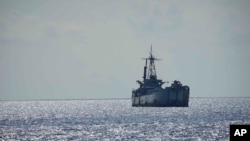China and the Philippines are blaming each other for a maritime collision that occurred Monday in the South China Sea near the Spratly Islands. Manila says the incident occurred in its exclusive economic zone when Chinese vessels engaged in dangerous maneuvers, but China’s coast guard blames a Philippine supply ship.
The incident is the latest in a string of confrontations in the disputed waters between the Philippines and China. Separately, just hours after the incident occurred, the United States said in a statement that it completed joint naval exercises in the Philippines’ EEZ with the Philippines, Japan and Canada.
According to China’s coast guard, a Philippine supply ship “deliberately and dangerously” made its way to one of China’s ships. The Chinese coast guard said the result was a minor collision after the supply ship “illegally intruded” by the submerged reef of Second Thomas Shoal in the Spratly Islands, a territory claimed by several nations.
In a statement on the social media app WeChat, the Chinese coast guard said the supply ship “ignored China's repeated solemn warnings … and dangerously approached a Chinese vessel in normal navigation in an unprofessional manner, resulting in a collision.”
The Philippine government did not comment directly on the incident itself but has pushed back against the accusation from China.
“We will not dignify the deceptive and misleading claims of the China Coast Guard,” said Xerxes Trinidad, chief of the Philippine armed forces’ public affairs office.
"The continued aggressive actions of the CCG are escalating tensions in the region."
Trinidad said the government would not talk about operational details regarding supply missions.
In a separate statement, Manila’s national task force on the West Philippine Sea — the name the Philippines uses for parts of the South China Sea in its EEZ — said China damaged Philippine boats after ramming them in a confrontation.
“The People's Liberation Army Navy, China Coast Guard and the Chinese Maritime Militia vessels engaged in dangerous maneuvers, including ramming and towing,” the task force said. “Their actions put at risk the lives of our personnel and damaged our boats.”
In a post on X, U.S. Ambassador to the Philippines MaryKay Carlson condemned China's "aggressive, dangerous" maneuvers, adding that the collision had "caused bodily injury."
China’s Foreign Ministry has described the coast guard’s recent activity as “professional, restrained, reasonable and lawful.”
China claims almost all of the South China Sea, which generates over $3 trillion maritime commerce annually. This includes parts claimed by the Philippines, Vietnam, Indonesia, Malaysia, Taiwan and Brunei.
Monday’s incident comes as China has taken steps to enhance enforcement in waters it claims as its own. Beijing recently announced new rules, effective June 15, that it says allow its coast guard to employ lethal force against foreign ships in its territorial waters and hold suspected trespassers without trial for 60 days.
In a response Monday, the Philippine Coast Guard said it has also deployed vessels to patrol Scarborough Shoal — located 641 kilometers (398 miles) north of Second Thomas Shoal — for the safety of Filipino fishermen.
